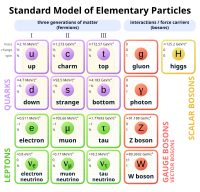
Photo from wikipedia
We applied a set of advanced bonding descriptors to establish the hidden electron density features and binding energy characteristics of intermolecular DH∙∙∙A hydrogen bonds (OH∙∙∙O, NH∙∙∙O and SH∙∙∙O) in 150… Click to show full abstract
We applied a set of advanced bonding descriptors to establish the hidden electron density features and binding energy characteristics of intermolecular DH∙∙∙A hydrogen bonds (OH∙∙∙O, NH∙∙∙O and SH∙∙∙O) in 150 isolated and solvated molecular complexes. The exchange‐correlation and Pauli potentials as well as corresponding local one‐electron forces allowed us to explicitly ascertain how electron exchange defines the bonding picture in the proximity of the H‐bond critical point. The electron density features of DH∙∙∙A interaction are governed by alterations in the electron localization in the H‐bond region displaying itself in the exchange hole. At that, they do not depend on the variations in the exchange hole mobility. The electrostatic interaction mainly defines the energy of H‐bonds of different types, whereas the strengthening/weakening of H‐bonds in complexes with varying substituents depends on the barrier height of the exchange potential near the bond critical point. Energy variations between H‐bonds in isolated and solvated systems are also caused the electron exchange peculiarities as follows from the corresponding potential and the interacting quantum atom analyses complemented by electron delocalization index calculations. Our approach is based on the bonding descriptors associated with the characteristics of the observable electron density and can be recommended for in‐depth studies of non‐covalent bonding.
Journal Title: Journal of Computational Chemistry
Year Published: 2021
Link to full text (if available)
Share on Social Media: Sign Up to like & get
recommendations!